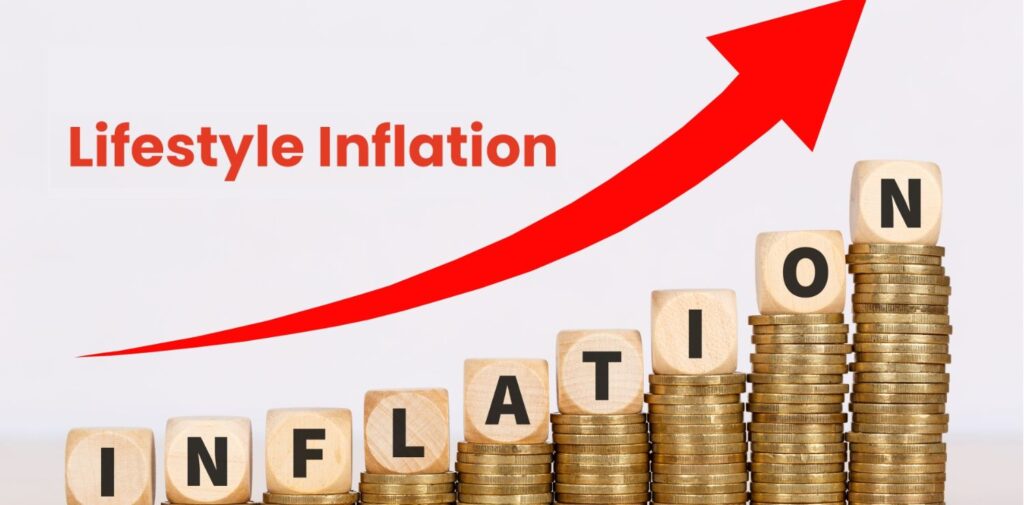In today’s fast-paced world, it’s easy to fall into the trap of lifestyle inflation, where an increase in income leads to an immediate upgrade in how we live. The moment a bonus hits your bank account, you may find yourself tempted to buy that sleek new car, splurge on high-end fashion, or book a luxurious vacation. While treating yourself after hard work is natural, upgrading your lifestyle too quickly can have long-term financial consequences. Instead, a more strategic approach is to invest your additional income into assets first, allowing those assets to eventually pay for the lifestyle you desire.
This method, commonly referred to as “delaying lifestyle inflation,” is a proven financial principle that can significantly impact your long-term wealth and security. In this article, we will explore why it’s essential to resist the temptation of immediate lifestyle upgrades and how investing in assets first can lead to financial freedom.
The Temptation of Lifestyle Inflation
One of the most common financial traps people fall into is lifestyle inflation. As your income increases, it seems logical to upgrade your lifestyle to reflect your new earnings. It could mean purchasing a bigger house, getting a more luxurious car, dining at high-end restaurants, or indulging in designer clothes. After all, you’ve worked hard, and you deserve to enjoy the fruits of your labor, right?
The problem with this mindset is that it creates a cycle where increased earnings are immediately consumed by increased spending, leaving little to no room for saving or investing. This phenomenon can prevent people from achieving true financial freedom, as they continually chase after the next income increase to maintain an ever-more-expensive lifestyle.
For instance, upgrading your car the moment you get a raise may provide short-term satisfaction, but it won’t contribute to your long-term wealth. The same goes for constantly updating your wardrobe or going on extravagant vacations. These expenses, while enjoyable in the moment, don’t offer any return on investment.

The Long-Term Impact of Lifestyle Inflation
Lifestyle inflation can have a significant impact on your ability to save and invest for the future. Here’s how it works: If every time you earn more, you spend more, your savings rate remains stagnant. Even though your income has increased, you’re not building wealth at a faster rate. In fact, in some cases, people find themselves in greater debt due to increased spending, especially when they finance their lifestyle upgrades with credit.
This cycle of spending more as you earn more can lead to what’s known as the “rat race”—a never-ending cycle where you’re working to earn just enough to maintain an expensive lifestyle, rather than building a financial cushion or investing for the future.
In contrast, resisting lifestyle inflation and keeping your spending in check can allow you to allocate your increased income toward savings and investments. This strategy can set you up for financial security, enabling you to retire early or pursue other life goals without the pressure of maintaining a high income to support an inflated lifestyle.
The Power of Investing in Assets
Instead of instantly upgrading your lifestyle when your income rises, a more financially prudent approach is to invest in assets that will generate passive income over time. Assets are things that put money into your pocket, even when you’re not actively working. They include investments such as stocks, bonds, real estate, or starting a business.
When you invest in assets, you’re essentially planting seeds for future financial growth. These investments have the potential to appreciate in value and provide a return on investment. Over time, as your assets grow, they can start generating enough income to cover your desired lifestyle upgrades without relying solely on your paycheck.
Let’s say you receive a promotion and your salary increases by 20%. Instead of immediately upgrading your car, you could invest that extra income into a diversified portfolio of stocks and bonds. Over the years, the returns from these investments could grow, providing you with passive income. Eventually, this passive income can cover the cost of upgrading your lifestyle—without jeopardizing your financial security.
This is the concept of letting your assets pay for your lifestyle, rather than using your earned income to cover discretionary expenses. By following this approach, you’re ensuring that your wealth grows while simultaneously enjoying the benefits of a more comfortable lifestyle.
Understanding the Difference Between Assets and Liabilities
To adopt this strategy, it’s essential to understand the difference between assets and liabilities. Simply put, assets are things that increase in value over time or generate income. Liabilities, on the other hand, are things that cost you money over time.

For example, buying a rental property is an asset because it can generate rental income and appreciate in value. On the other hand, purchasing a new car is a liability because it depreciates in value and requires ongoing expenses like maintenance, insurance, and fuel.
When you prioritize investing in assets first, you’re focusing on building things that increase your net worth and provide long-term financial security. In contrast, upgrading your lifestyle without first investing in assets can lead to accumulating liabilities that drain your financial resources over time.
The Concept of Delayed Gratification
At the heart of delaying lifestyle inflation is the concept of delayed gratification. This is the ability to resist the temptation of immediate rewards in favor of achieving long-term goals. It’s about making sacrifices now so that you can enjoy greater rewards in the future.
Delayed gratification is a critical component of financial success. By postponing lifestyle upgrades, you’re giving yourself time to build a strong financial foundation. This doesn’t mean you have to live an austere life, but rather that you make thoughtful choices about when and how you spend your money.
For example, instead of upgrading your car the moment you get a raise, consider driving your current car for a few more years while you invest the difference. Or instead of booking a dream vacation right away, set aside money in an investment account and let it grow. By exercising patience and discipline, you’ll be able to enjoy these luxuries down the line—without sacrificing your financial health.
Real-Life Examples of Delayed Lifestyle Inflation
Many financially successful people have embraced the idea of delayed lifestyle inflation, and their stories serve as powerful examples of how this approach can lead to long-term wealth.
Take Warren Buffett, for example. Despite being one of the wealthiest individuals in the world, Buffett is known for his frugal lifestyle. He still lives in the same modest home he purchased in 1958, and he’s famous for driving older cars and eating simple meals. Buffett’s wealth comes from his disciplined approach to investing in assets rather than spending on luxury items.
Similarly, many successful entrepreneurs and investors prioritize reinvesting their profits into their businesses or investments, rather than upgrading their personal lifestyles. This focus on building assets first allows them to create sustainable wealth that can eventually support a more luxurious lifestyle—without the financial stress.

How to Resist Lifestyle Inflation
Resisting lifestyle inflation isn’t always easy, especially in a world that encourages consumption and keeping up with appearances. However, there are several strategies you can implement to stay focused on your financial goals:
- Set Clear Financial Goals: Define your long-term financial goals, such as buying a home, retiring early, or achieving financial independence. Having clear goals will help you stay motivated to save and invest, rather than spending on short-term lifestyle upgrades.
- Create a Budget: A budget can help you track your spending and ensure that you’re allocating enough money toward savings and investments. Stick to your budget even when your income increases to avoid lifestyle inflation.
- Automate Your Savings: Set up automatic transfers to your savings or investment accounts every time you receive a paycheck. This way, you’re paying yourself first and ensuring that your money is going toward building assets.
- Practice Gratitude: Take time to appreciate the things you already have. Your current car, home, or wardrobe may still serve you well, even if you have the means to upgrade.
- Surround Yourself with Like-Minded People: It’s easier to resist lifestyle inflation when you’re surrounded by people who share similar financial values. Avoid the temptation to keep up with others who may be upgrading their lifestyles.
Conclusion
Delaying lifestyle inflation and investing in assets first is one of the most powerful strategies for building long-term wealth. By resisting the urge to upgrade your lifestyle with every increase in income, you’re giving yourself the opportunity to grow your assets and achieve financial freedom. Eventually, your investments will provide the income needed to support the lifestyle you desire, allowing you to enjoy life without financial stress. In the end, it’s not about depriving yourself but about making smarter financial choices that lead to lasting prosperity.




